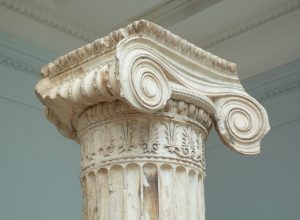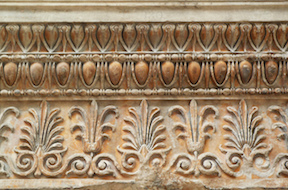These graceful female figures replace columns—how did human form and architecture relate in ancient Greece?
Caryatid (South Porch) and Ionic Column (North Porch), Erechtheion on the Acropolis, Athens, marble, 421-407 B.C.E., Classical Period (British Museum, London). Mnesicles may have been the architect.
The caryatid
The Erechtheion is perhaps the most complex building on the Acropolis. It houses shrines to several different deities, including Athena, Zeus and Poseidon. It is named for the mythic King Erechtheus who judged the contest between Athena and Poseidon for who would be the patron deity of Athens.
This caryatid is one of six elegant female figures who supported the roof of the south porch of the Erechtheion (figures who do the work of columns—carrying a roof—are called caryatids). The figure wears a garment pinned on the shoulders (this is a peplos—a kind of garment worn by women in ancient Greece). The drapery bunches up at the waist and pours over the belt. She stands in contrapposto with her left knee bent and pressing against the drapery The folds of drapery on other right side resemble the fluting (vertical grooves) on a column. She looks noble and calm despite the fact that she carries the weight of a roof on her head.

Ionic Column (North Porch), Erechtheion on the Acropolis, Athens, marble, 421-407 B.C.E., Classical Period (British Museum, London). Mnesicles may have been the architect.
The column
The Erechtheion is a highly decorated and elegant Ionic temple. The scroll forms at the top of the column (the capital) and its tall slender profile indicate that this is the Ionic order. The column is formed of four pieces (known as “drums”) and is fluted (decorated with vertical grooves). Just below the scroll shapes (also called volutes) you see decorative moldings, including one called “egg and dart” (egg shapes alternating with V-shapes), and below that a ring of plant-like shapes—an alternating palmette and lotus pattern.
These decorative patterns also appear on the entablature of the Erechtheion (the entablature is the horizontal area carried by the columns).

Entablature from the Erechtheion, Acropolis, Athens, marble, 421-407 B.C.E. (British Museum, London)
Smarthistory images for teaching and learning:
[flickr_tags user_id=”82032880@N00″ tags=”caryatid,”]
[0:00] [music]
Dr. Steven Zucker: [0:04] We’re in the British Museum. We’re looking at one of the caryatids from the Erechtheion from the Acropolis in Athens.
Dr. Beth Harris: [0:13] Yes.
Dr. Zucker: [0:14] That’s a lot of information. [laughs]
Dr. Harris: [0:16] A caryatid is a human figure acting as column.
Dr. Zucker: [0:21] She looks like a column.
Dr. Harris: [0:22] She does. Her drapery falls in what almost looks like the fluting of a column, those vertical ridges.
Dr. Zucker: [0:30] And because she stands in contrapposto with one weight-bearing leg, which is the one that looks like a column, and one free leg so that the knee juts forward, that drapery is allowed to fall completely free of the body below. There’s a very subtle and very sensitively-handled sway to her body.
[0:50] The contrapposto is not just in the legs, but even in the hips, which you can’t actually see because of all the cloth, but which are referred to.
Dr. Harris: [0:58] We have this nice circular form around her hips that…
Dr. Zucker: [1:01] Where the peplos just bunches.
Dr. Harris: [1:04] Right, that tunic that she’s wearing and that pools down around her waist, falling from her breasts in a very graceful way.
Dr. Zucker: [1:13] It’s interesting, because we were talking about the sway of the body, but by the time you get up to the capital, up to her head, she’s straightened out. She has to be. You can get a sense of even the specificity, the weight, the thickness of the cloth. The way a peplos worked, it was pinned at the shoulders. You can really get a sense that this is not a very thin fabric. It’s got a certain heaviness to it.
Dr. Harris: [1:34] A weight to it.
Dr. Zucker: [1:35] If you look at the porch where this came from, there are six caryatids altogether, four facing forward. And the two on the right oppose the two on the left in terms of the contrapposto, I believe with the weight-bearing leg on the outside always to make it feel more stable. There’s a sensitivity to…
Dr. Harris: [1:54] Harmony, balance.
Dr. Zucker: [1:55] Absolutely.
Dr. Harris: [1:56] There’s a nobility to her that is very much what we’ve been seeing when we also looked at the Parthenon sculptures. We’re in 5th century B.C. Greece, the Classical era, and that sense of ideal, perfect beauty, and nobility, and monumentality.
Dr. Zucker: [2:14] I also find it really interesting, this idea of conflating an architectural element with the human body, because that’s something that is a very ancient idea, and here it’s done in the most direct way. Later, the Romans will talk about architecture in terms of the human body, not only in terms of scale but also in terms of proportion. Here, it’s taken to the most literal extreme.
Dr. Harris: [2:40] Within the same room is a fabulous Ionic column, also from the Erechtheion, which is very graceful and grows more slender as it rises toward the top, with a lovely Ionic capital with decorative carving underneath.
[2:57] Having this column here is a really important reminder of the scale of those buildings on the Acropolis. Because when you’re standing in the museum, you forget the scale…
Dr. Zucker: [3:09] How big these buildings were.
Dr. Harris: [3:09] …of these buildings, and on top of a hill in Athens, and the way there’s a nice skylight above it because it begins to give you a sense of what it’s like in natural light to see the stone.
Dr. Zucker: [3:20] This is, as you said, an Ionic column, which is a much more slender, much more graceful column than the heavy Doric, the massiveness that we see in the Parthenon, which is just across the way on the Acropolis.
[3:34] I think this is a little sexist, but sometimes this order, the Ionic, is referred to as a more feminine…
Dr. Harris: [3:41] Right, more elegant, more graceful, more decorative.
Dr. Zucker: [3:43] Of course, the female figures are replacing the actual columns, so there’s this kind of synthesis of those two.
Dr. Harris: [3:49] And the lovely fluting that makes this wonderful play of light and dark across the column.
Dr. Zucker: [3:54] Fluting, and unlike the Doric, there is a base. The column doesn’t rise directly out of the stylobate. There’s this footing, and, of course, that beautiful scrolled capital.
[4:03] [music]




